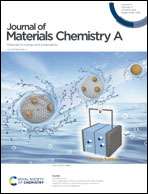Alloy engineering in mixed Sn–Ge perovskites for photovoltaic application†
Abstract
Recently, mixed Sn–Ge perovskites have been proposed as promising lead-free candidates in the photovoltaic (PV) field. However, as an important component of mixed Sn–Ge perovskites, the all-inorganic Sn-based perovskites have a dominant defect, SnI (Sn replacing I, anti-site), which induces a deep level in the band structure and limits the power conversion efficiency. Therefore, it is interesting to discover whether SnI and GeI (Ge replacing I, anti-site) can still act as non-radiative recombination centers in mixed Sn–Ge perovskites. Using first-principles calculations, we explored the effects of SnI and GeI in CsGe1−xSnxI3 (x = 0.25, 0.50, and 0.75) on the PV performances. It was shown that both SnI and GeI are benign only in CsGe0.5Sn0.5I3, and we suggest that CsGe0.5Sn0.5I3 is a promising light-absorbing material with benign defects (GeI and SnI), strong light absorption, and small carrier effective masses. Interestingly, the concerted action of alloying on both band edges and defect states was found to result in better defect properties in CsGe0.5Sn0.5I3, and this is different from results of previous studies where the modulation of introducing alloys on defects is mainly caused by regulating the band edges alone. Our work not only provides theoretical guidance for the experimental synthesis of mixed Sn–Ge perovskites with superior PV performances, but it also shows the potential of alloy engineering in regulating defect levels in perovskites.



 Please wait while we load your content...
Please wait while we load your content...